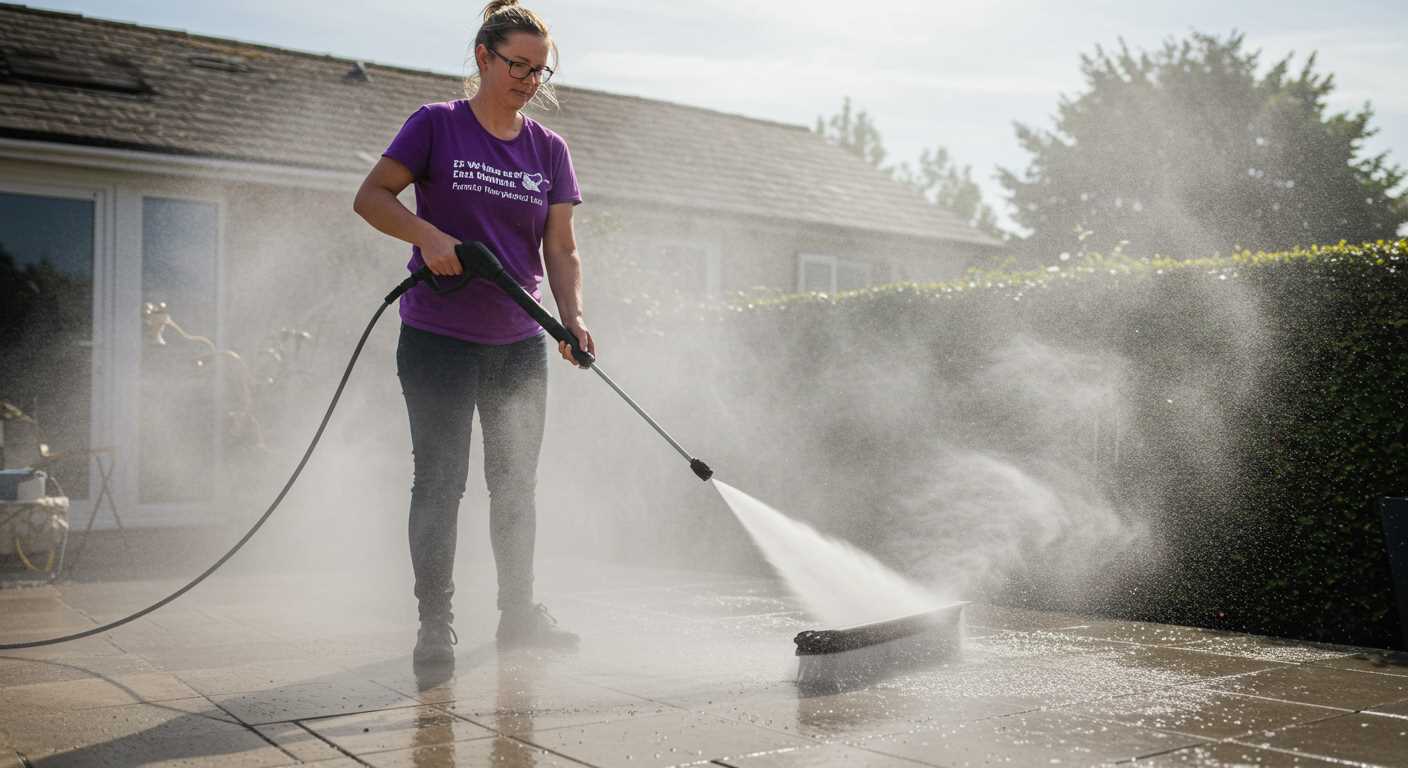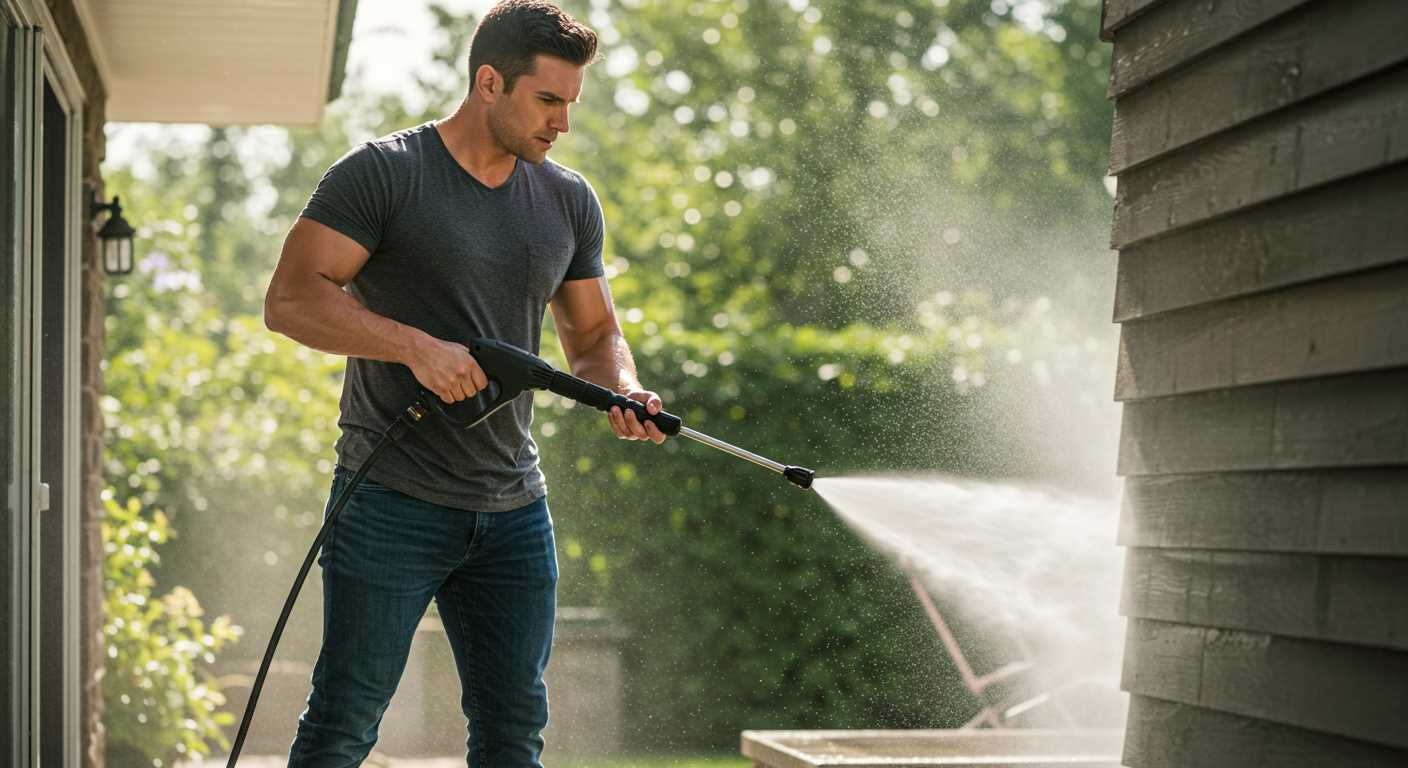



For optimal results when utilising high-pressure equipment, I highly recommend a sodium hypochlorite solution, particularly for porous surfaces. This chemical effectively eradicates moss, algae, and mildew, ensuring the surface remains clean for an extended period. Mixing a solution of one part sodium hypochlorite to nine parts water creates an effective cleaning agent without causing damage to your outdoor surfaces.
When addressing tougher stains, a proprietary detergent specifically designed for use with high-power machines proves beneficial. Look for products with a high concentration of biodegradable surfactants, which break down grime without harming the surrounding environment. These detergents can enhance the cleaning capabilities of your high-pressure unit, allowing you to tackle dirt and stains more efficiently.
It’s also beneficial to consider attachments that enhance the cleaning process. Rotating brush nozzles and surface cleaners can significantly increase the effectiveness of your equipment, ensuring comprehensive coverage and reducing the time needed for completing tasks. Incorporating these tools complements the cleaner you choose and can make a noticeable difference in results.
Optimal Solutions for Paving Surface Restoration
The ideal choice for restoring the surface area lies in selecting a cleaner formulated for specific materials. For stone surfaces, a formula containing phosphoric acid provides deep penetration, effectively tackling grime and organic growth. On the other hand, oxygen bleach is excellent for concrete and brick as it eliminates stains without causing harm to the materials.
Choosing Detergents
Pairing the right detergent with the cleaning device can significantly enhance the outcomes. A biodegradable, pH-neutral product reduces environmental impact while delivering thorough results. For extra tough stains, a concentrated alkaline cleaner effectively breaks down oil and grease accumulation.
Technique and Application
Applying the solution correctly boosts efficiency. Spray the detergent evenly over the surface and allow it to dwell for 10-15 minutes, which facilitates the breakdown of the dirt. Afterward, use the appropriately chosen nozzle to maximise water pressure and maintain a consistent distance of approximately 30cm from the surface for optimal control.
In sum, utilising the right formulations along with effective application techniques ensures superb restoration results for various surfaces.
Understanding Different Patio Materials for Cleaning
When tackling dirt and grime on exterior surfaces, knowing the type of material can significantly influence the approach you take. Here’s a breakdown of common materials found on outdoor spaces and how to effectively maintain them with cleaning techniques.
Natural Stone
Natural stone surfaces, such as slate or granite, require gentle handling. Use a lower pressure setting to avoid etching or damaging the surface. A mix of warm water and a mild stone cleaner is often sufficient to remove stains. Rinse thoroughly to prevent residue buildup.
Concrete
.jpg)
Concrete is durable but can be stained easily. High-pressure solutions are useful here, but consider using a specific concrete cleaner to tackle oil spots or mildew. After applying a suitable cleaner, pressure washing can effectively eliminate embedded dirt.
Brick
Brick surfaces should be approached with caution, as excessive force can dislodge mortar. Use a fan spray nozzle at a moderate setting combined with a brick-specific detergent. Continuous rinsing helps prevent dirt from redepositing in the porous structure.
Wood
Wooden decking is susceptible to damage from high-pressure and harsh chemicals. Opt for a wood cleaner and set the machine to a light pressure while maintaining a safe distance to avoid splintering. Always finish with a rinse and possibly a wood sealer to protect against future damage.
Composite Materials
Composite decks are generally resilient. A mild detergent mixed with water, followed by pressure washing on a medium setting, works well. Ensure thorough rinsing to remove all cleaning agent traces, as these can lead to discolouration over time.
- Assess surface type before starting any maintenance.
- Choose the appropriate cleaning solution based on material.
- Adjust pressure settings to prevent damage.
- Always rinse well to remove residues.
Understanding these materials allows for more tailored and effective upkeep strategies. Prioritising the right techniques not only enhances the lifespan of these surfaces but also keeps them looking pristine.
Choosing the Right Nozzle for Your Outdoor Surface

To maximise cleaning performance, I recommend using a 25-degree nozzle for most outdoor surfaces. This nozzle strikes a good balance between pressure and coverage. It’s particularly useful for tackling dirt and grime without damaging delicate stone or tile materials.
Understanding Nozzle Types
Nozzles come in various angles–0, 15, 25, and 40 degrees–each designed for specific tasks. The 0-degree nozzle produces a concentrated jet suitable for heavy stains but can cause surface damage. The 15-degree option offers more power, ideal for caked-on grime, while the 40-degree choice provides a gentle spray suitable for rinsing and less stubborn residues.
Pressure Settings
Adjusting the pressure settings on the machine is crucial. For softer surfaces like wood or composite materials, lower settings paired with a wider nozzle prevent damage. For tougher surfaces such as concrete, increasing the pressure with a narrower nozzle can yield better results. Always conduct a test on a small, inconspicuous area to ensure compatibility.
By selecting the appropriate nozzle and pressure setting, I have consistently achieved excellent results without compromising the integrity of the surfaces. With these tips, you can efficiently maintain your outdoor spaces with ease.
Comparing Cleaning Solutions for Pressure Washing Patios
For optimal results in the quest for a spotless outdoor surface, selecting the right solution is paramount. Mild detergents work effectively for less stubborn grime, while specialised formulations targeting mould or mildew can tackle tougher stains. Always check the compatibility of a chosen agent with the surface material to avoid damage.
Types of Solutions
Traditional soap-based cleaners can be sufficient for general maintenance. However, for surfaces prone to biological growth, consider using a product with a biocide. Acid-based solutions are particularly useful for concrete or stone, helping to break down mineral deposits. Be vigilant with application and rinse thoroughly to prevent any potential surface etching.
Eco-Friendly Options
If sustainability is a concern, several eco-friendly formulas exist. These are often plant-based and biodegradable, offering a safer alternative for gardens and landscaping. Many users find success with vinegar solutions mixed with water, providing an efficient natural cleaning method without harmful chemicals.
Identifying Stains and Debris on Patios
Recognising the type of stains and debris present on outdoor surfaces is fundamental for choosing an appropriate approach to restoration. Common stains include organic growths such as moss and algae, oil or grease marks, rust, and mineral deposits. Each requires different methods and solutions.
Moss and algae thrive in damp environments, often leaving a slippery surface. For effective treatment, examine shaded areas where moisture accumulates. An eco-friendly biocide can help eliminate these growths.
Oil or grease stains frequently originate from nearby BBQs or vehicles. Use an absorbent powder, such as baking soda or commercial degreaser, to lift these marks before the high-powered stream is applied.
Rust is prevalent on metal furniture that may come into contact with water. For this, a rust remover or a solution containing oxalic acid should be tested before utilising a high-pressure device.
Mineral deposits, often white chalky stains, occur due to hard water. A vinegar solution can help break down these deposits effectively.
| Stain Type | Identification | Recommended Treatment |
|---|---|---|
| Moss/Algae | Green or black patches, slimy | Biocide solution |
| Oil/Greas | Dark, shiny spots | Baking soda or commercial degreaser |
| Rust | Brown, orange stains | Rust remover or oxalic acid |
| Mineral Deposits | White chalky residue | Vinegar solution |
Before starting the restoration process, ensure all debris such as leaves and dirt are cleared. This not only enhances visibility but also prevents additional stains during high-pressure application. Proper identification ensures that time and effort contribute to effective results.
Step-by-Step Guide to Pressure Washing a Patio
To successfully refresh any outdoor surface, follow these concise steps. Begin by removing furniture, potted plants, and any obstructions. This creates an unobstructed workspace.
Next, sweep the area thoroughly to eliminate loose debris and dirt. Take time to examine for any stains or mould that require special attention prior to using the machine.
Prepare the chosen cleaning solution according to the manufacturer’s instructions. Allow it to activate by applying it generously onto the surface. Wait approximately 10-15 minutes for optimal penetration.
Attach the appropriate nozzle to the sprayer. For most surfaces, a 25-degree nozzle will suffice; for tougher stains, consider a 15-degree option. Maintain a consistent distance of about 12 inches from the surface for even results.
Start at one end and work systematically to the other end. Use sweeping motions while gradually overlapping each stroke to ensure thorough coverage. Avoid lingering too long in one spot to prevent damage.
Once finished, rinse the area thoroughly with clean water. This step removes any excess cleaning solution and residue.
Lastly, allow sufficient drying time before placing furniture back or stepping onto the area. Regular maintenance with these techniques will keep the surface in excellent condition.
Safety Precautions When Using a Pressure Washer on Patios
Always wear protective gear, including safety goggles, gloves, and non-slip shoes. This prevents injuries caused by flying debris and slippery surfaces.
Preparation Steps
- Ensure the area is free from obstacles and furniture to minimise risks.
- Check the pressure appliance for any leaks or damage before starting.
- Confirm that all connections are secure, especially hoses and nozzles.
Before beginning, it’s crucial to identify any electrical outlets, gas lines, or water sources that could pose a hazard. Maintain a distance of at least 10 feet from these elements while operating the equipment.
Operational Guidelines
- Keep a firm grip on the handle to maintain control during usage.
- Never direct the spray towards people, pets, or windows.
- Adjust the spray angle as needed and stay aware of your surroundings.
Store the unit safely when not in use. Unplug the power supply and drain the water from the hoses to prevent freeze damage in colder months. By following these guidelines, the cleaning task becomes much safer and more effective.
Maintaining Your Outdoor Surface After Deep Cleaning
.jpg)
After using a high-powered device to revitalize your outdoor area, it’s crucial to follow up with some simple maintenance steps. First, ensure that any remaining debris, such as leaves or dirt, is removed to prevent staining and keep the area tidy.
Consider applying a sealant suitable for the material of your surface. This protective barrier can significantly prolong the cleanliness achieved through the washing process. Typically, it’s recommended to reapply sealant every couple of years, depending on weather conditions and wear.
Regular Inspections
Conduct regular checks for any signs of deterioration, such as cracks or shifts in the surface. Addressing these issues early can prevent further damage. Also, inspect for mould or algae growth, especially in shaded areas. If you spot any, treat these spots promptly with an appropriate fungicidal solution.
Seasonal Care

During fall and spring, clear away organic material that may accumulate. Invest in a broom designed for outdoor surfaces to simplify this task. In winter, consider shovelling off snow rather than using salt, which can cause fading and damage over time. Maintaining the area throughout the year will preserve its appearance and structural integrity.










